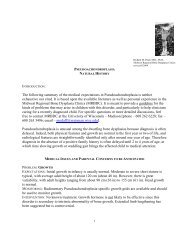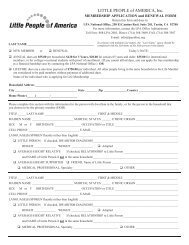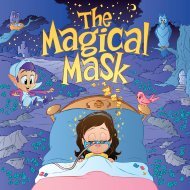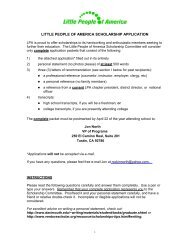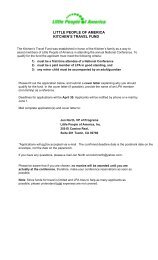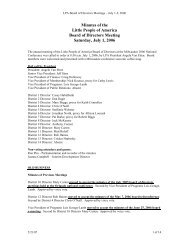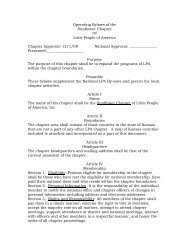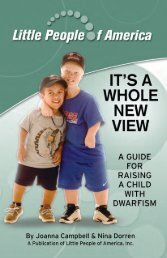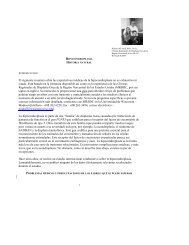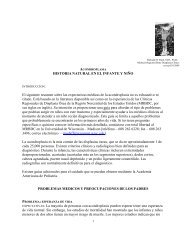Diastrophic Dysplasia - Little People of America, Inc.
Diastrophic Dysplasia - Little People of America, Inc.
Diastrophic Dysplasia - Little People of America, Inc.
- No tags were found...
You also want an ePaper? Increase the reach of your titles
YUMPU automatically turns print PDFs into web optimized ePapers that Google loves.
DIASTROPHIC DYSPLASIANATURAL HISTORYRichard M. Pauli, M.D., Ph.D.,Midwest Regional Bone <strong>Dysplasia</strong> Clinicsrevised 9/2009INTRODUCTION:The following summary <strong>of</strong> the medical expectations in <strong>Diastrophic</strong> <strong>Dysplasia</strong> is neitherexhaustive nor cited. It is based upon the available literature as well as personal experience in theMidwest Regional Bone <strong>Dysplasia</strong> Clinics (MRBDC). It is meant to provide a guideline for thekinds <strong>of</strong> problems that may arise in children with this disorder, and particularly to help clinicianscaring for a recently diagnosed child. For specific questions or more detailed discussions, feelfree to contact MRBDC at the University <strong>of</strong> Wisconsin – Madison [phone – 608 262 6228; fax –608 263 3496; email – modaff@waisman.wisc.edu].<strong>Diastrophic</strong> <strong>Dysplasia</strong> is a severe dwarfing disorder. Although it does result in small stature, infact, the more problematic issues in this disorder are joint related. It arises because <strong>of</strong> a genechange that results in abnormalities <strong>of</strong> the extracellular matrix that, in turn, give rise toabnormalities <strong>of</strong> the joints – deformation under loading (such as weight bearing), abnormalmobility, and early and severe degenerative changes.Our understanding <strong>of</strong> the medical issues in <strong>Diastrophic</strong> <strong>Dysplasia</strong> is, to a large extent, dependentupon studies done in Finland. This is the most common dwarfing disorder in those <strong>of</strong> Finnishdescent. Unfortunately, it is not certain whether everything learned from evaluation <strong>of</strong> affectedFinns is applicable to affected individuals in other countries. Most affected individuals <strong>of</strong> Finnishdescent are homozygous for the same mutation in the both copies <strong>of</strong> the gene that causes<strong>Diastrophic</strong> <strong>Dysplasia</strong>, while most individuals in other populations have diverse mutations. Thismay result in differences in severity, in variability etc., which currently cannot be taken intoaccount.MEDICAL ISSUES AND PARENTAL CONCERNS TO BE ANTICIPATEDPROBLEM: GROWTHEXPECTATIONS: Anticipated average height is around 46-48 inches. However, there is extremevariability with some individuals above 60 inches. There are two diagnosis specific growth gridsavailable; unfortunately one is based on a limited number <strong>of</strong> individuals (n=72) while the other is1
exclusively based on Finnish individuals. The latter may not be applicable to all populations(and, indeed, shows considerably higher height ranges than seems typical in the U.S.).MONITORING: Length/height monitoring should occur at least every six months using one <strong>of</strong> theavailable diagnosis specific linear growth grids.INTERVENTION: As an intrinsic abnormality <strong>of</strong> bone and cartilage, growth hormone therapywould not be expected to be <strong>of</strong> any benefit. No growth hormone trials have been carried out.Extended limb lengthening, which may be a consideration in some bone dysplasias, has not beenutilized in <strong>Diastrophic</strong> <strong>Dysplasia</strong> and likely is contraindicated given response to surgery ingeneral (see below).PROBLEM: CENTRAL NERVOUS SYSTEM AND COGNITIVE FUNCTIONEXPECTATIONS: There are no abnormalities <strong>of</strong> the brain, no risk for hydrocephalus and nosignificant risk for cognitive abnormalities.MONITORING: Anticipate severe gross motor and fine motor delays based on biophysicaldifferences; for example, average age for independent walking is around 24 months. There arecrude diagnostic specific standards for motor development available.INTERVENTION: Physical therapy with gentle range <strong>of</strong> motion activities should begin early in life.Occupational therapy for activities <strong>of</strong> daily living and for fine motor and adaptive needs,particularly related to hand abnormalities, will be needed later.PROBLEM: RESPIRATORYEXPECTATIONS: Laryngotracheobronchomalacia is common in infancy. Indeed, the increasedmortality that seems to be present in the first year <strong>of</strong> life may arise solely on the basis <strong>of</strong>unappreciated airway compromise.MONITORING: Historical and clinical assessment <strong>of</strong> respiratory status should be done early ininfancy.INTERVENTION: If stridor or distress seems apparent then involvement <strong>of</strong> a pediatricpulmonologist should be obtained.PROBLEM: PALATEEXPECTATIONS: About 30-60% have cleft palates.MONITORING: Early physical assessment.INTERVENTION: If present, the cleft should be closed at the usual time. If present, there is a highrisk for middle ear dysfunction. Any child with palatal abnormality should have behavioralaudiometry and tympanometry beginning at around 9-12 months <strong>of</strong> age and around every 6months thereafter. If persistent serous otitis develops, early myringotomy and tube placement isappropriate.PROBLEM: DENTAL AND ORTHODONTIAEXPECTATIONS: About one-third will have hypodontia. Many will develop bite abnormalities,most commonly a narrow anterior palate, open bite and cross bite abnormalities.MONITORING: Initial pediatric dentistry and orthodontic assessment by around 5 years <strong>of</strong> age.2
INTERVENTION: Palatal expansion may be an option. Traditional orthodontia will usually beneeded. Orthognathic surgery is sometime appropriate in later childhood or early adulthood.PROBLEM: EAR ABNORMALITIESEXPECTATIONS: Most infants develop cystic changes <strong>of</strong> the ears. These are <strong>of</strong> no functionalsignificance. Over time these will transform into stiff, 'cauliflower' ears.MONITORING: Anticipate such changes for the parents.INTERVENTION: These may arise because <strong>of</strong> a predisposition to microcartilage damage secondaryto minor trauma. Most likely the cystic changes arise from rubbing <strong>of</strong> the ears against bed sheets.If the parents wish, 'ear cups' may be fabricated to protect the ears for the first few months <strong>of</strong> life.Cystic changes are less likely to arise after this. If cystic changes develop, they should not beneedled, drained etc., which treatments carry risk <strong>of</strong> further deformation, infection etc.PROBLEM: CERVICAL SPINEEXPECTATIONS: C-spine bifidity is exceedingly common and apparently <strong>of</strong> no clinicalsignificance. Nearly all infants will have kyphosis <strong>of</strong> the cervical spine with an apex in the midcervicalregion. In around 20-30% this will progress and persist through childhood; in theremainder there is spontaneous resolution. In addition, there is intrinsic narrowing <strong>of</strong> the spinalcanal in the cervical region and, in some, mild instability. These three features, together, meanthat those with severe kyphosis are at risk for neurologic compromise secondary to cordcompression and lower medullary compression, as well as at increased risk for traumaprecipitated neurologic abnormality. The greatest risk appears to be in early to mid- childhood,since after that increasing degenerative changes negate the abnormal instability <strong>of</strong> the cervicalspine that is initially present.MONITORING: Lateral cervical spine radiographs (flexion, neutral and extension) should becompleted at 3 mo, 6 mo and every 6 months thereafter until around 4 years <strong>of</strong> age. In those withmarked kyphosis, careful neurologic examination for signs <strong>of</strong> cervical myelopathy must becompleted every 3-6 months. In those with kyphosis, special care to prevent head and neckinjury should be discussed with the family.INTERVENTION: Should any signs <strong>of</strong> cervical myelopathy develop, cervical fusion with or withoutdecompression will be needed, sometimes urgently.PROBLEM: THORACOLUMBAR SPINEEXPECTATIONS: Scoliosis or kyphoscoliosis is exceedingly common, with around 7 out <strong>of</strong> every8 individuals showing a significant curvature. Kyphoscoliosis may be <strong>of</strong> very early onset, <strong>of</strong>tenwithin the first two years <strong>of</strong> life, with around 10% showing a very early, rapidly progressivecurve.MONITORING: Clinical evaluation should be at least every six months, with radiographswhenever any clinical evidence for a curve developing arises. Monitoring must be compulsive(e.g. clinical and radiologic reassessments every 6 months) in those who develop curves, so thattimely surgical fusion can be carried out.3
INTERVENTION: Aggressive bracing <strong>of</strong>ten will be needed, although overall the results <strong>of</strong> bracinghave been discouraging. At best, bracing may delay the time <strong>of</strong> surgical intervention. Combinedanterior and posterior surgical approaches will frequently be needed.PROBLEM: HIPSEXPECTATIONS: Some newborns will have severe hip flexion contractures. In most, hip flexioncontractures, if not present initially, will nonetheless develop early. Hip dysplasia develops inmany, <strong>of</strong>ten at the time <strong>of</strong> the assumption <strong>of</strong> orthograde posture. Sometimes there will be frankdislocation. More <strong>of</strong>ten there will be progressive degenerative changes. Avascular necrosisfrequently becomes evident.MONITORING: Evaluate hip mobility in infancy. Orthopedic and radiologic assessment <strong>of</strong> the hipsshould occur within the first year <strong>of</strong> life, again after assumption <strong>of</strong> orthograde posture and then atleast yearly thereafter.INTERVENTION: Gentle physical therapy for hip flexion contractures may have modest benefit.There is great controversy about the best way <strong>of</strong> managing the chronic, progressive hip problems(dysplastic changes, progressive limitation <strong>of</strong> movement). Some advocate aggressive, sequentialbony surgeries, while others suspect that such surgery ultimately does not result in markedimprovement <strong>of</strong> function. Limited experience suggests that extensive s<strong>of</strong>t tissue releases (similarto that used in children with cerebral palsy) may be <strong>of</strong> some benefit. Total hip arthroplasty can bedone successfully in adults.PROBLEM: KNEESEXPECTATIONS: Initially there is instability <strong>of</strong> the knee. Then, over time, stiffness develops.Because <strong>of</strong> the presence <strong>of</strong> hip flexion contractures, knee flexion contractures and equinusdeformity <strong>of</strong> the feet, individuals will <strong>of</strong>ten have a metastable “Z-posture” – secondary to flexionat the hip, flexion at the knee and toe walking. Sometimes there is frank, persistent dislocation <strong>of</strong>the patella. In later childhood degenerative arthritic changes arise.MONITORING: Evaluation <strong>of</strong> knee mobility in infancy and throughout early childhood shouldoccur. Orthopedic assessment <strong>of</strong> the knees should occur within the first 2 years <strong>of</strong> life, and thenat least yearly thereafter.INTERVENTION: It is not clear what, if anything should be done related to the abnormalities <strong>of</strong>knee position and function. Extension osteotomies should be considered if the knee flexioncontractures are sufficiently severe to limit ambulation. Patellar dislocation might be effectivelysurgically treated. Total knee arthroplasty can be done successfully in adults.PROBLEM: CLUBFOOTEXPECTATIONS: More than 90% are born with club foot abnormality, usually severe and usuallyassociated with great toe malposition.MONITORING: Assess clinically.INTERVENTION: Often the clubfoot is resistant to usual surgeries and will frequently recur aftersurgery. Initiate physical therapy for range <strong>of</strong> motion immediately. Anticipate early orthopedicsurgical correction, which will need to be aggressive and radical. Such surgery should only beundertaken by an experienced pediatric orthopedist. Often multiple surgeries will be needed with4
various salvage procedures used in an attempt to establish plantigrade feet. Custom fitted shoesare usually needed.PROBLEM: HANDSEXPECTATIONS: 'Hitchhiker' thumbs are nearly constant. Generalized extension camptodactyly(fingers fixed in extension) is usual.MONITORING: Clinical assessmentINTERVENTION: Physical therapy with gentle range <strong>of</strong> motion activities begun early in life maybe <strong>of</strong> limited benefit. Occupational therapy for fine motor and adaptive needs related to handabnormalities will be needed. Various adaptive devices may be needed, although children <strong>of</strong>tenshow remarkable fine motor abilities despite severe abnormalities <strong>of</strong> position and mobility.Allowing children to find such alternative adaptive strategies to compensate for their limitedfinger mobility is appropriate. Surgery is probably always contraindicated and may cause furtherharm.PROBLEM: MIGRATORY ARTHRALGIASEXPECTATIONS: There has been little documentation <strong>of</strong> this problem, but it seems to be quitecommon.MONITORING: -INTERVENTION: Use <strong>of</strong> nonsteroidal anti-inflammatory agents appears to be effective. Morningarthralgias may be benefited by use <strong>of</strong> an egg crate mattress, first morning warm baths, etc.PROBLEM: RISKS OF SURGERYEXPECTATIONS: Although controversial, experience and the molecular basis <strong>of</strong> diastrophicdysplasia both suggest that individuals with this disorder can not respond normally tocartilaginous damage. It is conceivable that this is the reason that the results <strong>of</strong> surgery are <strong>of</strong>tendisappointing. Indeed, this suggests that the fewest possible number <strong>of</strong> bony and cartilaginousprocedures should be done.MONITORING: -INTERVENTION: Limit the number <strong>of</strong> surgeries on bone and cartilage to those clearly essential forfunction.PROBLEM: ADAPTIVEEXPECTATIONS: Considerable psychological and physical adaptive needs may arise later inchildhood.MONITORING: Assess for age appropriate needs.INTERVENTION: School adaptations, stools, adaptations for toileting, adaptations for dressing andundressing, occupational therapy monitoring, motorized scooter for long distance mobility,teacher involvement, <strong>Little</strong> <strong>People</strong> <strong>of</strong> <strong>America</strong> involvement.5
GENETICS AND MOLECULAR BIOLOGY<strong>Diastrophic</strong> dysplasia is always an autosomal recessive disorder. As for other recessiveconditions, there is a 25% risk that siblings <strong>of</strong> an affected individual will be similarly affected.No other family members should have any substantially increased risk. As noted, the diastrophicdysplasia gene is far more common in Finns (presumably secondary to a founder affect).It is now known that diastrophic dysplasia is caused by mutations in what is termed the<strong>Diastrophic</strong> <strong>Dysplasia</strong> Sulfate Transporter (DTDST). Mutations in both copies <strong>of</strong> this gene resultin decreased availability <strong>of</strong> substrates for sulfation and secondary decreased sulfation <strong>of</strong>proteoglycans. Other, more severe mutations in this same gene result in other, rare and moresevere bone growth disorders including atelosteogenesis type II and achondrogenesis type I-B,while milder mutations cause a recessive type <strong>of</strong> multiple epiphyseal dysplasia.Prenatal diagnosis (and preimplantation diagnosis using assisted reproductive technologies) canbe accomplished by gene analysis. Ultrasonography is also a highly accurate prenatal diagnosticmethod.6



